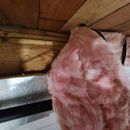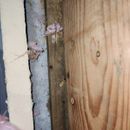Insulating 4′ OC Rim joist
Hello everyone,
I have a house with a crawlspace + slab on grade attached garage in Portland, OR (Zone 4C). The crawlspace is (mostly) encapsulated and I’d like to insulate the rim joists however it’s a construction style I’m not familiar with. The house is supported by 4′ OC beams (6 or 8×12) running the length of the house. As a result the cavities are 4′ wide along the short edge of the house and 10-12′ along the long edge.
I was thinking of fitting the cavities with 1.5-2″ rigid polyiso and sealing the edges with spray foam or caulk. While I’m at it I could make the rigid foam continuous with the existing rigid foam pretty easily. Then, since it’s there anyway, reattaching the batt insulation.
Am I overlooking anything?
Thank you for the help,
~Alex
GBA Detail Library
A collection of one thousand construction details organized by climate and house part











Replies
The picture doesn't discribe the type of wall assembly you have, but I would use sprayed ccSPF unless the assembly has rigid foam on the outside. If you use polyiso on the outside, you can use ocSPF on the inside.
Thanks for the advice!
The outside is fiber cement siding. The reason for avoiding (solely) spray foam is b/c I'm doing this myself and I'm not likely to get the entire rim joist in one session (and I'd be worried about making a huge mess).
Alex,
Your plan sounds good. Try and air-seal (with caulk, foam, or tape) the new foam to the existing.
Thanks Malcolm,
I hadn't thought of using tape for the flat seams between the new and existing foam. And for that matter the vertical seams along the long edge. That'd be much easier and I'd think a bit stronger mechanically; not that the assembly has to survive much more than an inadvertent whack when putting the batts back in place.
(Edit: moved from accidental general reply)
Deleted